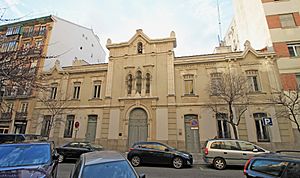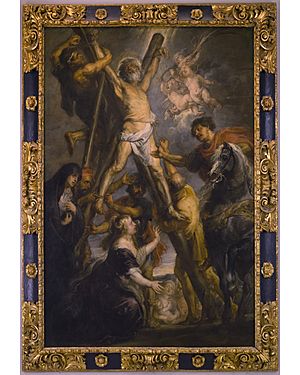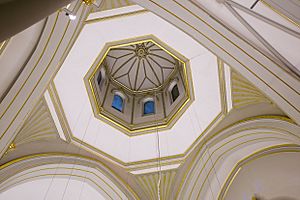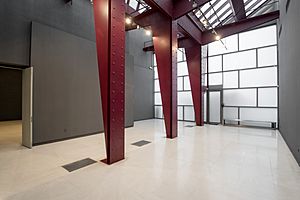Fundación Carlos de Amberes facts for kids
Quick facts for kids Carlos de Amberes Foundation |
|
|---|---|
| Native name Spanish: Fundación Carlos de Amberes |
|
 |
|
| Location | Madrid, Spain |
| Built | 1877 |
| Architect | Agustín Ortiz de Villajos Manuel Ortiz de Villajos |
| Architectural style(s) | Eclecticism |
| Official name: Fundación Carlos de Amberes | |
| Type | Non-movable |
| Criteria | Monument |
| Designated | 1994 |
| Reference no. | RI-51-0007300 |
| Lua error in Module:Location_map at line 420: attempt to index field 'wikibase' (a nil value). | |
The Carlos de Amberes Foundation (in Spanish: Fundación Carlos de Amberes) is a special non-profit organization. It was started way back in 1594. Its first job was to give a place to stay for poor people and travelers. These travelers came from a region called the Seventeen Provinces of the Netherlands. This area is now countries like Belgium, Luxembourg, the Netherlands, and parts of Northern France. They were visiting the royal court in Madrid.
Today, the Foundation does many cool things. It supports projects, events, and books about history, science, and art. It also hosts art shows, concerts, talks, and workshops. Its main focus is on the history of Europe, especially Spain and the Benelux countries (Belgium, Netherlands, Luxembourg). It also helps people think about how Europe has grown and changed.
Contents
History of the Foundation
The Foundation began as the Royal Board of Saint Andrew of the Flemish. Its main goal was to help poor people and travelers from the Seventeen Provinces of the Netherlands.
How it Started in 1594
The story of the Royal Board of Saint Andrew of the Flemish began in 1594. A man named Charles of Antwerp (Carlos de Amberes in Spanish) gave away some of his properties. He wanted them to be a shelter for poor people from the Seventeen Provinces after he died. These people were visiting the Court of Madrid.
Charles of Antwerp passed away in 1604. A soldier named Miguel du Frêne helped make Charles's idea real. With support from the Flemish guard, he created a new hospital for the poor. It was named after Saint Andrew, who was important to the Duchy of Burgundy.
Royal Support and New Rules
In 1606, King Philip III of Spain agreed to support the Foundation. He and the kings after him would be in charge. The first rules, made in 1616, said that people from the Seventeen Provinces or their descendants should run the Foundation.
In 1621, a new building was planned in Madrid. It would have a hospital and a church. A famous Flemish painter, Peter Paul Rubens, was asked to create a painting in 1636. This painting, called the Martyrdom of Saint Andrew, was placed in the church's main altar. It has stayed with the Foundation for over 380 years and still has its original frame!
Overcoming Challenges
The Foundation faced very hard times in 1798. The government took over many hospitals and charities. It almost disappeared. Things got even worse during the time of King Ferdinand VII. The building was hard to keep up, and the old church collapsed in 1848.
But thanks to Belgian diplomats in Madrid, the Foundation got help from the Spanish Crown. It was able to recover. On November 30, 1877, a new hospital and church opened. King Alfonso XII and the Princess of Asturias were there. The new building was on Claudio Coello Street in a modern part of Madrid. This church became the first parish in the Salamanca district. The Carlos de Amberes Foundation has been there ever since.
Becoming a Cultural Center
The Royal Hospital of San Andrés de los Flamencos is one of the few places that has lasted over 400 years. It is now one of the oldest non-profit private foundations in Europe. It has changed and grown thanks to the hard work of its leaders and helpers.
The Foundation completely changed its purpose after 1988. It asked Juan Carlos I of Spain to become a cultural organization. It stopped being just about charity and helping the poor. After the King approved, it became a Private Cultural Foundation.
Soon, the old building, designed by Agustín and Manuel Ortíz de Villajos, was updated. The building, which had an eclectic style, was built in the 1800s as a church, inn, and infirmary. It was greatly changed to fit the Foundation's new goals. Architects created a modern cultural center. They added an auditorium, exhibition halls, a library, and offices.
On November 25, 1992, the Kings of Spain, Don Juan Carlos and Doña Sofía, opened the newly renovated building. The Kings of Belgium, Baudouin I and Queen Fabiola, were also there. The Foundation became a major cultural center in Madrid. From that year on, it started new activities. These activities promote cultural, historical, and scientific connections between Spain and the former Netherlands Provinces. These areas are now the Netherlands, Luxembourg, Belgium, and France. The building itself was recognized as important for culture in 1994.
Library and Collections
The Foundation has a library with over 4,000 books. These books focus on European topics, French and Dutch literature, and the history and art of the former Seventeen Provinces. Many books came from the Belgian Embassy and from donations.
The Foundation also displays a portrait of the Second Marquis of Casa Riera. This painting was given to the Foundation by Queen Fabiola of Belgium in 1997. It also has a beautiful symphonic harmonium from 1857. This musical instrument is unique in Spain. Many concerts have been played on it since it was fixed in 1994.
What the Foundation Does
Since 1992, the Carlos de Amberes Foundation has offered many different activities. These include art shows (photography, modern art, history) and talks. They also host poetry readings and concerts of classical and jazz music. You can even rent their spaces for private events.
Exhibitions to Explore
The Foundation has hosted over 60 exhibitions. Some very important ones include photos by Edward Steichen, René Magritte, and Man Ray. They have also shown old scientific instruments, astrolabes, and clocks from the 1500s. Artworks by Rembrandt and Van Dyck have been displayed too.
Other shows have featured maps from Flanders and the Netherlands by Blaeu and Mercator. The famous illustrator Hergé and his character Tintin have also had exhibitions. Modern artists like M. C. Escher and Toulouse-Lautrec have been featured too.
Historical exhibitions have covered topics like "The end of the Flanders War" and "The Royal Alcázar of Madrid." The Foundation has also organized shows outside Madrid. For example, "Philip I the Handsome, beauty and madness" was shown in Burgos and Bruges.
From November 2014 to August 2015, the Carlos de Amberes Museum opened. It showed works by Flemish and Dutch masters. These included paintings by Rubens, Pieter Brueghel the Elder, and Anton van Dyck. The museum explored different types of Flemish painting, like portraits and landscapes.
Concerts and Music
Since 1992, more than 80 concerts have been held in the Foundation's auditorium. These include chamber music and performances by solo artists and singing groups from around the world. About 15 concerts happen each year. Many famous music schools and groups have performed there.
The Foundation has also released music recordings. These include music from the time of Philip I the Handsome. They have also helped share the music of Spanish composer Juan Oliver y Astorga.
Interesting Conferences
The conferences at the Carlos de Amberes Foundation cover many topics. They talk about history, culture, and European issues. They also celebrate famous historical people and big events.
Since 1999, the Foundation has held an International History Seminar every year. These seminars look at topics like "The Empire of Charles V" and "Art in the Court of the Catholic Kings." They also discuss "The War of the Spanish Succession."
Other talks have focused on figures like the Duke of Alba and William of Orange. They have also explored painters like Van Dyck and Vermeer.
Many important Spanish and European politicians have given talks at the Foundation. These include Felipe González and José María Aznar. The Foundation also discusses how European countries work together.
Other Activities and Partnerships
Besides all these activities, the Foundation also does research. It offers special courses with universities like the National University of Distance Education (UNED). It also hosts seminars and presentations by well-known writers.
The Carlos de Amberes Foundation works with many other organizations and companies. This helps them achieve their goals even better. Some of these partners include the Assembly of Madrid, several universities, and the National Library of Spain. They also work with the Cervantes Institute and various foundations and banks.
The auditorium and exhibition halls can be rented for events. The auditorium has great sound quality. This makes it perfect for recording all kinds of chamber music.
See also
 In Spanish: Fundación Carlos de Amberes para niños
In Spanish: Fundación Carlos de Amberes para niños






